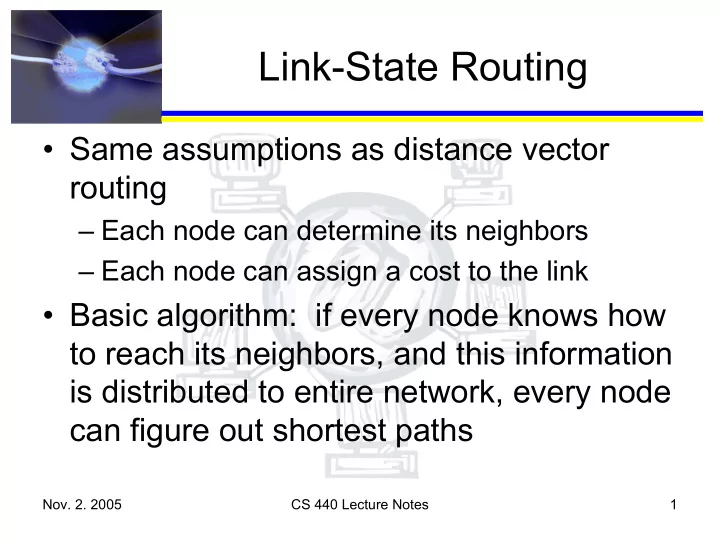

Link-State Routing • Same assumptions as distance vector routing – Each node can determine its neighbors – Each node can assign a cost to the link • Basic algorithm: if every node knows how to reach its neighbors, and this information is distributed to entire network, every node can figure out shortest paths Nov. 2. 2005 CS 440 Lecture Notes 1
Link-State Routing (cont.) • Requires two mechanism – Reliably distribute link-state information – Compute routes from this information • First mechanism uses reliable flooding – Each node sends information out on all links – Each node that receives forwards information on all other links Nov. 2. 2005 CS 440 Lecture Notes 2
Link State Packets • LSPs contain the following: – ID of node that created LSP – List of directly connected nodes, with costs – Sequence number – TTL • Last two fields added to improve reliability of flooding Nov. 2. 2005 CS 440 Lecture Notes 3
Reliability • Exchange of LSP with neighbors uses reliable protocol • When node receives LSP – Stores if it doesn’t already have on from that source – If it already has the LSP and new seq # greater than stored value, updates entry and forwards to all other neighbors Nov. 2. 2005 CS 440 Lecture Notes 4
Generating LSPs • Done in two circumstances: – Periodically – When topology changes • Same techniques to detect as used in distance vector routing • To reduce LSP traffic, use long timers for periodic updates; since LSPs are reliably distributed, don’t need to be updated very often Nov. 2. 2005 CS 440 Lecture Notes 5
Generating LSPs (cont.) • Every time LSP is updated, seq. # incremented – Starts at 0 when node reboots – Node may receive its own updated LSP from another node – just starts using that seq # • LSPs discarded when TTL expires – TTL decremented before node floods to neighbors, ages when stored in node. When TTL is 0, node discards LSP Nov. 2. 2005 CS 440 Lecture Notes 6
Route Calculation • Entire network topology known from LSPs • Node uses Dijkstra’s shortest-path algorithm to compute routes – Constructs graph of network from LSPs – Algorithm uses adjacency matrix to represent graph: N is set of nodes, l(i,j) is cost of edge from i to j, i, j in N , cost = ∞ if no connection – Also keeps M , set of nodes incorporated so far, and C(n) , cost of path from start node s to node n Nov. 2. 2005 CS 440 Lecture Notes 7
Dijkstra’s Algorithm • M = [ s ] for each n in N – s C(n) = l(s, n) while ( N ≠ M ) M = M U { w }, where C(w ) minimum for all w in ( N – M ) for each n in ( N – M ) C(n) = min( C(n) , C(w) + l(w, n) ) Nov. 2. 2005 CS 440 Lecture Notes 8
Forward Search Algorithm • Modified version of Dijkstra’s algorithm that builds routes directly from LSPs – forward search algorithm – Doesn’t require creation of graph from LSPs – Maintains two lists, Tentative and Confirmed . Each list has entries (Dest, Cost, NextHop) Nov. 2. 2005 CS 440 Lecture Notes 9
Forward Search (cont.) 1. Initialize Confirmed with entry for current node (S, 0, -) 2. For node just added, Next , select its LSP 3. For each neighbor N of Next , cost ( s , N ) = cost ( s , Next) + cost ( Next,N ) 1. If N not in Confirmed or Tentative , add ( N , cost , NextHop ) to Tentative 2. If N in Tentative and cost <current cost, replace with new entry 4. If Tentative empty, stop. Otherwise, pick Tentative entry with least cost, move to Confirmed , select as Next , and go to 2 Nov. 2. 2005 CS 440 Lecture Notes 10
Link-State Tradeoffs • Advantages: – Does not generate much routing table traffic – Responds quickly to topology changes • Disadvantages – Requires a lot of storage in each router • Link-state vs. distance vector: – Link-state talks to everyone, only tells them what it knows definitely – Distance vector talks only to neighbors, tells them everything it thinks it has learned Nov. 2. 2005 CS 440 Lecture Notes 11
Open Shortest Path First Protocol (OSPF) • Most common link-state protocol • Adds the following to basic link-state: – Authenticate routing messages – Additional hierarchy – partition routing domain into areas . For other nodes outside a router’s area, router only needs to know how to get to area – Load balancing –multiple routes can have same cost and both be used by router Nov. 2. 2005 CS 440 Lecture Notes 12
OSPF Messages • Five types: “Hello” to let neighbors know router is alive, plus messages to request, send, and acknowledge data • Based on Link-State Advertisement messages (LSAs) – One to send cost of links between routers – One to send networks to which router is directly connected – One to send area information Nov. 2. 2005 CS 440 Lecture Notes 13
Recommend
More recommend